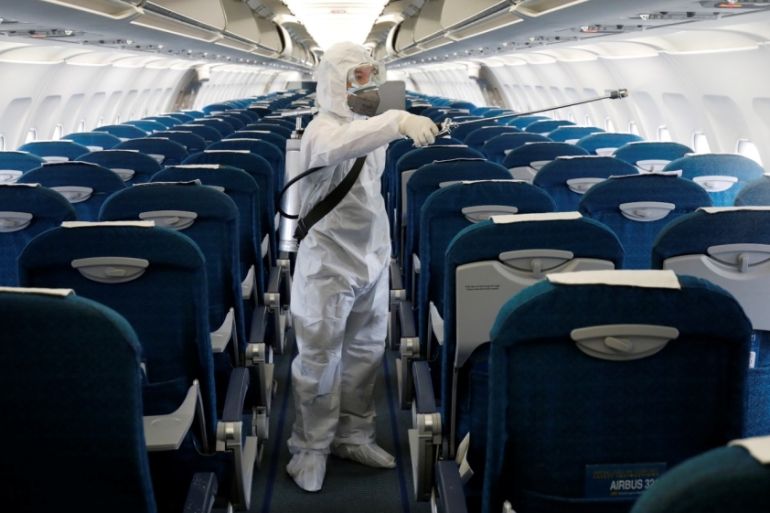Airlines get lifeline from governments – at a price
New Zealand and the US offer loans with potential stock options to carriers affected by the virus outbreak.

Shattered airlines have been left counting the cost of government support as politicians in the United States and New Zealand set out conditions for bailouts needed to absorb the shock of the coronavirus.
Conditions include provisions that loans may convert to government equity stakes, with Air New Zealand Ltd’s bailout also dependent on suspending its dividend and paying interest rates of 7 percent to 9 percent, while US airlines cannot increase executive pay or provide “golden parachutes” for two years.
Keep reading
list of 3 itemsUS considers airline bailouts to ease COVID-19’s economic impact
Governments offer airlines aid as coronavirus forces flight cuts
New Zealand on Friday offered its national carrier a New Zealand dollar 900 million ($510m) lifeline, which Finance Minister Grant Robertson said would help it survive after the government banned all non-resident arrivals to the country.
“That puts us in a very good position over the next several months,” Air New Zealand chief executive Greg Foran told reporters of the loan, which it will not draw down immediately. “We would expect the airline industry will look different at the end of this. Not all airlines are going to survive.”
Based on the $58bn US proposal for passenger and cargo carriers, the US Treasury Department could receive warrants, stock options or stock as a condition of government assistance in order for the government to participate in gains and be compensated for risks.
“We are not bailing out the airlines or other industries – period,” US Senate Appropriations Committee Chairman Richard Shelby said in a statement. “Instead, we are allowing the Treasury Secretary to make or guarantee collateralized loans to industries whose operations the coronavirus outbreak has jeopardised.”
Norway will back airlines with credit guarantees worth up to 6 billion Norwegian crowns ($537m), half of it to Norwegian Air Shuttle ASA, but conditions include raising some money from commercial lenders and the equity market.
The International Air Transport Association (IATA) has forecast the industry will need up to $200bn of state support, piling pressure on governments facing demands from all quarters and a rapid worsening in public finances as economies slump.
“The longer this crisis lasts, the more likely it is that the future of aviation cannot be guaranteed without state aid,” Carsten Spohr, chief executive of Germany’s Lufthansa said on Thursday.
Lufthansa, which has idled 700 of its 763 aircraft, has already held talks with the German government on providing liquidity, including through special loans from state development bank KfW.
Some have disagreed with government bailouts of airlines, including former United Nations ambassador Nikki Haley, who resigned from Boeing Co’s board on Thursday after opposing its bid for $60bn in government financial assistance.
“I cannot support a move to lean on the federal government for a stimulus or bailout that prioritizes our company over others and relies on taxpayers to guarantee our financial position,” Haley said in a March 16 letter that Boeing disclosed on Thursday. “I have long held strong convictions that this is not the role of government.”
Even with financial assistance, airlines around the world are placing thousands of workers on unpaid leave, deepening the shocks to local economies.
Some airlines are looking to place their staff with temporary employers. Air New Zealand may redeploy some workers to the government, possibly in health roles and contact tracing, New Zealand’s finance minister told reporters.
Qantas is talking to Australian retailer Woolworths Group Ltd about job opportunities as grocery sales surge, while more than 1,000 laid-off SAS airline workers in Sweden are being offered fast-track healthcare training to help fight the coronavirus.
The only bright spot for the industry is the cargo market. Passenger planes normally carry about half the world’s air cargo in their bellies, with the remainder hauled in dedicated freighter planes.
The collapse in passenger flights has tightened the cargo market, leading some carriers to fly planes devoid of passengers and baggage but with cargo in their bellies.
American Airlines Group Inc said on Thursday it would use some of its grounded Boeing 777 passenger jets to move cargo between the US and Europe, in its first scheduled cargo-only flights since 1984 when it retired the last of its 747 freighters.
Normally 65 percent of cargo capacity from mainland Europe and the United Kingdom to the US is belly space on passenger aircraft, according to Seabury Consulting.
“Space is available, but at premium rates and without transit time guarantees,” logistics company Agility said on its website.
In the Asia-Pacific region, Qantas Airways Ltd, Cathay Pacific Airways Ltd, Korean Air Lines Co Ltd are also operating some flights with empty seats but bellies full of cargo.